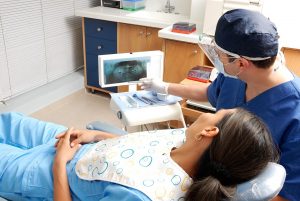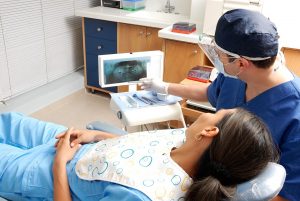Written by Chrystal Moulton, Science Writer. Regression analysis revealed that individuals with severe deficiency in vitamin D [< 25 nmol/ L] were 2.2 times more likely to have untreated dental cavities (P<0.05).
 Vitamin D is an essential fat-soluble nutrient that supports bone and dental health1,2. Research already demonstrates that diets lacking essential vitamins such as vitamin D, especially highly processed foods with high sugar content, can lead to dental caries3,4. One systemic review showed that vitamin D supplementation could significantly reduce the risk up dental carries5. However, few studies examine behavioral and environmental circumstances that could affect vitamin D status and dental health. In the current study, researchers investigated environmental, biological, and behavioral factors that could affect vitamin D status and the prevalence of dental caries in the US population6.
Vitamin D is an essential fat-soluble nutrient that supports bone and dental health1,2. Research already demonstrates that diets lacking essential vitamins such as vitamin D, especially highly processed foods with high sugar content, can lead to dental caries3,4. One systemic review showed that vitamin D supplementation could significantly reduce the risk up dental carries5. However, few studies examine behavioral and environmental circumstances that could affect vitamin D status and dental health. In the current study, researchers investigated environmental, biological, and behavioral factors that could affect vitamin D status and the prevalence of dental caries in the US population6.
Data from the National Health and nutrition examination survey (NHANES) between 2011- 2016 was used for this analysis. In particular, data during this time detailed prevalence of dental caries (or cavities) among members of the US population. The primary indicators of dental caries were the decaying, missing, and filled teeth index (DMFT) and the presence of untreated dental cavities. Blood samples were taken from participants in the NHANES study. Vitamin D status was measured using the samples. Demographic data, BMI, nutritional and food intake, family education level, and socioeconomic status was collected from each participant. Researchers used the Food Patterns Equivalent Database (FPED) to estimate sugar consumption. Chi-square test was used to assess statistical significance among categorical variables. Regression models were used to assess any association between vitamin D levels and dental cavities over time. Logistical regression was tested against three models:
- Model 1-Untreated dental cavities and vitamin D levels
- Model 2- untreated dental cavities, vitamin D levels, age, race/ ethnicity, sex, poverty income ratio, and educational background
- Model 3- all items listed in model 2 plus BMI and consumption of added sugar
Among 23,151 individuals, 18,683 participants were eligible for this assessment. The average DMFT score was 10.34 with a prevalence of untreated dental cavities at 33.2%. For added sugars, the average intake was 72.67g. The data showed the prevalence of untreated dental cavities was significantly higher among men at 34.4% (P = 0.02) then in women (32.1%). Among racial and ethnic groups, non-Hispanic black (36.7%), Mexican American (36.7%), Other Hispanic (33.1%), and non-Hispanic white (32.3%) had similar rates of untreated dental cavities (P<0.05). Researchers also found dental cavity is prevalent in individuals with lower levels of education (P<0.05). Also, individuals with higher BMI had a higher rate of untreated dental cavities (P<0.05). When comparing vitamin D status to sociodemographic variables, researchers observed that individuals in the lowest poverty to income ratio were generally deficient in vitamin D (P<0.05). Also, Mexican Americans, non-Hispanic black, and non-Hispanic Asians tended to be either insufficient or moderately deficient in vitamin D (P<0.05). Regression analysis revealed that individuals with severe deficiency in vitamin D [< 25 nmol/ L] were 2.2 times more likely to have untreated dental cavities (P<0.05). Even after adjusting against model 3 covariates, the risk of dental cavities was 95% (OR = 1.95, P<0.05) among those with severe vitamin D deficiency. In fact, after adjusting for model 3 covariates at each level of vitamin D insufficiency researchers calculated the risk untreated dental cavities as follows:
- 50-75 nmol/L vitamin D [insufficient]- OR= 1.21 [1.11- 1.31], (P<0.05)
- 25-50 nmol/L vitamin D [moderate deficiency]- OR= 1.36 [1.24- 1.50], (P<0.05)
- < 25 nmol/L vitamin D [severe deficiency]- OR= 1.95 [1.64- 2.33], (P<0.05)
Researchers also calculated the risk of the presence of dental cavities among various levels of vitamin D insufficiency after adjusting for model 3 covariates as follows:
- 50-75 nmol/L vitamin D [insufficient]- OR= 1.07 [1.06 – 1.08], (P<0.05)
- 25-50 nmol/L vitamin D [moderate deficiency]- OR= 1.11 [1.10 – 1.13], (P<0.05)
- < 25 nmol/L vitamin D [severe deficiency]- OR= 1.25 [1.21 – 1.28], (P<0.05)
Ultimately, data from this analysis showed that environmental factors associated with Vitamin D status, DMFT scores, and untreated dental cavities include race and ethnicity, educational level, poverty to income ratio, and BMI. Furthermore, low vitamin D status is significantly associated with higher risk of dental cavities.
Source: Hung, Man, Himani Patel, Samantha Lee, Justin Nguyen, and Amir Mohajeri. “The Influence of Vitamin D Levels on Dental Caries: A Retrospective Study of the United States Population.” Nutrients 16, no. 11 (2024): 1572.
© 2024 by the authors.Licensee MDPI, Basel, Switzerland. This article is an open access article distributed under the terms and conditions of the Creative Commons Attribution (CC BY) license (https://creativecommons.org/license
s/by/4.0/).
Click here to read the full text study.
Posted June 26, 2024.
Chrystal Moulton BA, PMP, is a 2008 graduate of the University of Illinois at Chicago. She graduated with a bachelor’s in psychology with a focus on premedical studies and is a licensed project manager. She currently resides in Indianapolis, IN.
References:
- Khazai N, Judd SE, Tangpricha V. Calcium and vitamin D: skeletal and extraskeletal health. Curr Rheumatol Rep. Apr 2008;10(2):110-7. doi:10.1007/s11926-008-0020-y
- Research NIoDaC. Dental Caries (Tooth Decay). https://www.nidcr.nih.gov/research/data-statistics/dental-caries#
- Louzada ML, Martins AP, Canella DS, et al. Impact of ultra-processed foods on micronutrient content in the Brazilian diet. Rev Saude Publica. 2015;49:45. doi:10.1590/s0034-8910.2015049006211
- Krzyściak W, Jurczak A, Kościelniak D, Bystrowska B, Skalniak A. The virulence of Streptococcus mutans and the ability to form biofilms. European journal of clinical microbiology & infectious diseases : official publication of the European Society of Clinical Microbiology. Apr 2014;33(4):499-515. doi:10.1007/s10096-013-1993-7
- Hujoel PP. Vitamin D and dental caries in controlled clinical trials: systematic review and meta-analysis. Nutr Rev. Feb 2013;71(2):88-97. doi:10.1111/j.1753-4887.2012.00544.x
- Hung M, Patel H, Lee S, Nguyen J, Mohajeri A. The Influence of Vitamin D Levels on Dental Caries: A Retrospective Study of the United States Population. Nutrients. 2024;16(11):1572.







Comments (0)